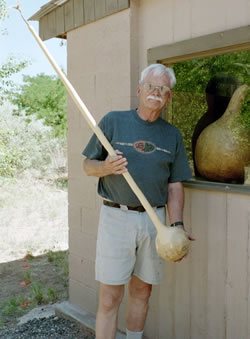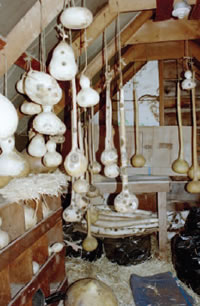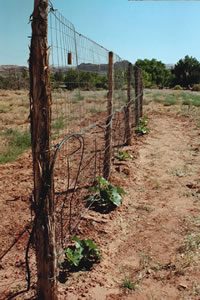|
 They
call themselves “gourd heads.” They are people
— not from another planet, but from our very own –
who like to grow gourds. They speak of these gourds as if
they are children, nurturing them from the time they are tiny
plants until they appear on the vine and grow like a baby
in the womb. You can actually watch them develop – form
necks and heads, waistlines and hips. The short story is this:
growing gourds makes gourd heads happy. We have one in Moab
– a gourd head, that is. His name is Bob Ridges. They
call themselves “gourd heads.” They are people
— not from another planet, but from our very own –
who like to grow gourds. They speak of these gourds as if
they are children, nurturing them from the time they are tiny
plants until they appear on the vine and grow like a baby
in the womb. You can actually watch them develop – form
necks and heads, waistlines and hips. The short story is this:
growing gourds makes gourd heads happy. We have one in Moab
– a gourd head, that is. His name is Bob Ridges.
Ridges isn’t content simply growing gourds, however.
Once he picks these beautiful treasures off the vine after
the first frost, he hangs them in “The Blue Goose,”
his drying shed. Here they stay for many months forming colorful
explosions of mold on their skin and subtly, and ever so slowly,
drying, until one day seeds rattle inside them and they are
ready to create art.
This is where it gets really interesting, especially when
it comes to the art of Bob Ridges. Undoubtedly one of the
most talented and creative gourd artists in the West, Ridges
lets each gourd speak to him. He holds it, studies it, watches
it, waiting for the inspiration to come which will tell him
whether this particular gourd wants to be a musical instrument,
a pot, a rattle, a rain stick, a jewelry box, a planter….or
maybe something he’s never created before.
 “I
never start on a gourd until I get an inspiration,”
Ridges said, standing in his drying shed with gourds of every
conceivable size and shape hanging around his head. “I
never start on a gourd until I get an inspiration,”
Ridges said, standing in his drying shed with gourds of every
conceivable size and shape hanging around his head.
“And I do confess, each one is like a child. Each is
individually special to me. I grow them, I clean them and
give them a lot of TLC,” said Ridges.
He took up the art of growing gourds about five years ago.
“I’ve always liked to grow things and gourds are
so fascinating,” he said. “I decided I wanted
to make some bird houses, so I grew some gourds, dried them,
and started cutting holes and designing bird houses, but the
birds didn’t like them. So, I changed the houses to
feeders and that was it. I was hooked on creating things out
of gourds.”
 Walking
through his studio there are gourds in every stage of creation.
Some are still wearing their moldy skin. Others are stripped
clean, shiny and smooth as… well…smooth as a baby’s
bottom. Some have been cut, but are not yet graced with Ridges’
exquisite wood-burned patterns. Others have been transformed
into musical instruments or lidded pots. Walking
through his studio there are gourds in every stage of creation.
Some are still wearing their moldy skin. Others are stripped
clean, shiny and smooth as… well…smooth as a baby’s
bottom. Some have been cut, but are not yet graced with Ridges’
exquisite wood-burned patterns. Others have been transformed
into musical instruments or lidded pots.
One instrument is an African mbira or what we call a “thumb
piano” in America. He makes flutes, rattles, drums and
has even tried his hand at a ukulele. He never paints his
gourds, rather uses wood burning tools to engrave intricate
patterns. One of his personal favorites is a gourd graced
with the image of a hummingbird. Others replicate famous rock
art panels that are seen around the region including the Great
Gallery from Horseshoe Canyon in Canyonlands National Park.
There is even melody in the growing and drying of gourds.
The seeds are planted after the first frost in the spring
and harvested before the first frost in the fall. They are
transferred to the drying shed until approximately March.
There is plenty of company in the shed. Each year Ridges grows
approximately 200-250 gourds each year.
“I have bags of gourds from five years ago that I haven’t
worked with. The inspiration hasn’t come and they are
too beautiful to make any mistakes,” he says laughing
about his tenderness toward the gourds.
 Gourds come in more shapes than is imaginable. Just a few
of the varieties in various stages of creation in Ridges’
studio are: Apple gourds, snake gourds, Chinese bottles, basketball
gourds, long handled dippers, bird house gourds, wine jugs,
bushel gourds and canteen gourds. There are many more. On
top of the dozens of existing varieties, gourds are known
to cross pollinate and create combinations of any of the varieties.
Gourds come in more shapes than is imaginable. Just a few
of the varieties in various stages of creation in Ridges’
studio are: Apple gourds, snake gourds, Chinese bottles, basketball
gourds, long handled dippers, bird house gourds, wine jugs,
bushel gourds and canteen gourds. There are many more. On
top of the dozens of existing varieties, gourds are known
to cross pollinate and create combinations of any of the varieties.
“Many more serious growers won’t allow for cross-pollination,”
said Ridges, “but I like it. It’s fun to see what
shows up on the vine!”
Some of the gourds that make an appearance on his vines are
very large. “I think the largest gourd I’ve ever
grown is 62 lbs. The smallest is a variety that simply doesn’t
get much bigger than about two inches,” explains Ridges.
Ridges also explains that the gourd is believed to be the
first cultivated plant in civilization. It is believed to
date back to 9000 B.C. in Egypt. It is estimated that it first
made its appearance in America in approximately 1000 B.C.
It is unknown how it came to arrive in America, but there
is documentation that a gourd once traveled by sea for 347
days and still had viable seeds, so almost anything is possible
when it comes to gourds.
 For those interested in growing gourds you should know that
they need considerable water. There are also plenty of other
folks around Moab and Castle Valley who lovingly call each
other “gourd heads.” Each year there is a Gourd
Festival in Castle Valley. For 2003 it is scheduled for October
25 at the Castle Valley Fire Station.
For those interested in growing gourds you should know that
they need considerable water. There are also plenty of other
folks around Moab and Castle Valley who lovingly call each
other “gourd heads.” Each year there is a Gourd
Festival in Castle Valley. For 2003 it is scheduled for October
25 at the Castle Valley Fire Station.
You can see some of Bob Ridges finished gourd art at Lema’s
Kokopelli Gallery at 70 N. Main Street in Moab. |